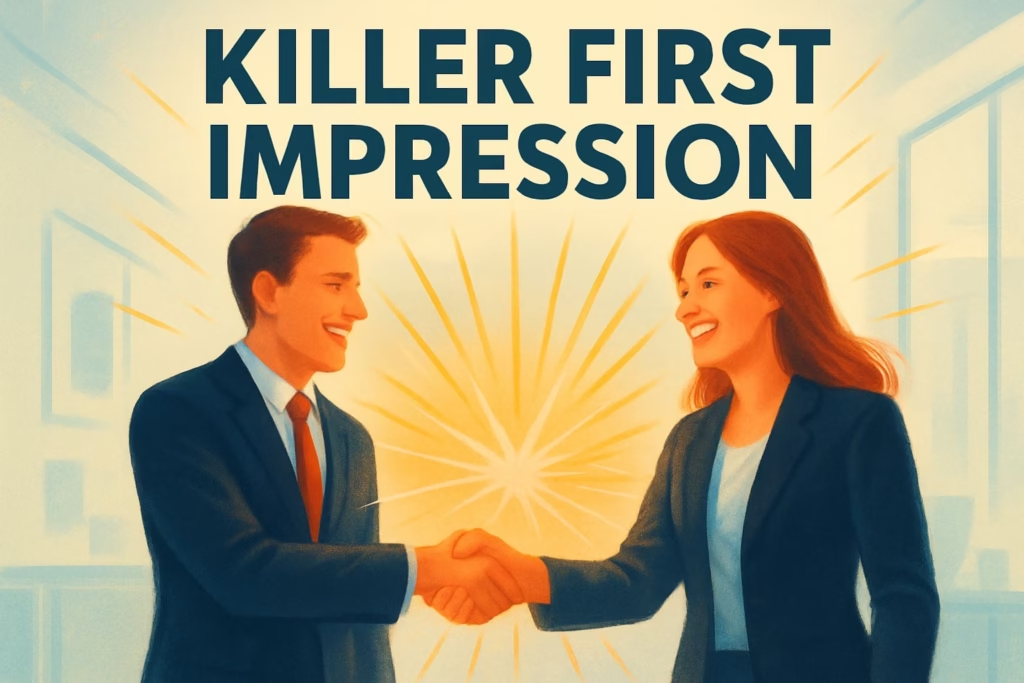The First 5 Minutes: How to Make a Killer First Impression

The first impression isn’t just a brief moment; it’s the invisible yet potent handshake of your professional persona, a foundational layer upon which every subsequent interaction is built. In the high-stakes arena of job interviews, pivotal client meetings, or crucial networking events, those initial five minutes are not merely a formality; they are the crucible in which judgments are forged, rapport is established, and opportunities are either seized or subtly slipped away. This isn’t about superficiality or adopting a false front; it’s about showcasing your inherent professionalism, radiating genuine confidence, and signaling a sincere eagerness to engage, right from the very outset. This comprehensive guide will meticulously dissect the critical components of forging an unforgettable first impression, meticulously addressing everything from the strategic precision of a perfect handshake and the magnetic pull of impactful eye contact to the nuanced art of engaging small talk and the deliberate cultivation of an overwhelmingly positive conversational tone. By thoroughly understanding, diligently practicing, and meticulously preparing for these crucial initial moments, you possess the power to transform a simple introduction into a profoundly memorable, advantageous, and opportunity-generating start to any interaction.
The Undeniable Power of the First Impression
Why do those initial moments command such extraordinary sway, often disproportionate to their brevity? The answer lies deep within the architecture of the human brain, which is hardwired for rapid, often subconscious, judgment. Within mere seconds – sometimes even milliseconds – our minds are busy assessing traits like trustworthiness, competence, warmth, and even social status. This phenomenon, often referred to as the “primacy effect,” means that the information encountered first carries significantly more weight than later information. If your first impression is overwhelmingly positive, people are cognitively primed to interpret your subsequent words, actions, and even minor missteps through a favorable, benevolent lens. This initial positive frame makes them more receptive, more inclined to trust, and more open to your ideas. Conversely, a poor or indifferent first impression erects an immediate, formidable uphill battle, requiring immense, sustained effort to even begin reversing those deeply etched negative perceptions. This profound psychological reality underscores the undeniable strategic importance of consciously and deliberately shaping your initial impact. It’s not about contriving an inauthentic version of yourself, but rather about presenting the most polished, confident, and genuinely engaged version of who you truly are, amplified and optimized by thoughtful, proactive preparation.

Phase 1: The Non-Verbal Overture – Body Language Speaks Volumes
Long before you utter a single word, your body is communicating. Mastering these non-verbal cues is paramount.
1. The Perfect Handshake: Your First Physical Connection
A handshake is far more than a customary greeting; it’s a profound tactile statement, a miniature ritual of connection that speaks volumes about your confidence, respect, and overall professionalism. It’s a moment of physical contact that can either build immediate rapport or create an instant barrier.
- Firm, Not Crushing – The Sweet Spot: The ideal handshake is a confident grip, conveying strength, certainty, and assertiveness without being aggressive. Think of it as a mutual respect. A “dead fish” (limp, weak) handshake can subconsciously signal nervousness, disinterest, or even a lack of conviction, instantly undermining your perceived capability. Equally, a bone-crushing grip can come across as overly aggressive, dominant, or even intimidating, making the other person uncomfortable. The sweet spot is a firm, comfortable pressure.
- Web-to-Web Contact – The Foundation of Connection: Crucially, ensure that the web of your thumb makes full, complete contact with the web of their thumb. This seemingly minor detail ensures full palm-to-palm connection, which signifies openness, honesty, and a willingness to engage authentically. A partial or fingertips-only handshake can feel awkward, distant, and insincere, suggesting you’re holding something back.
- One or Two Pumps – The Brief, Professional Rhythm: A brief, controlled motion, typically one or two pumps originating from the elbow, held for approximately two to three seconds, is the universally accepted and professional standard. Avoid any prolonged, lingering shake, which quickly becomes uncomfortable and awkward, or a rapid, dismissive pump that can suggest haste or disinterest.
- Direct Eye Contact – Reinforcing Sincerity: Concurrent with the handshake, always establish and maintain direct eye contact. This vital non-verbal cue powerfully reinforces sincerity, engagement, and confidence. It tells the other person, “I am present, I am focused on you, and I respect this interaction.”
- Dry Hands – The Preemptive Strike: If you know you are prone to nervous or sweaty palms, proactively manage this. A quick, discreet wipe of your hand on your pants or with a tissue just before the greeting can prevent an uncomfortable, clammy handshake. This small act of preparedness speaks volumes about your attention to detail.
- Cultural Nuances – Awareness is Respect: While the firm handshake is a Western business norm, it’s always wise to be subtly aware of cultural variations. In some cultures, a softer touch might be preferred, or direct physical contact might be less common. However, for most professional contexts in North America and Europe, the guidelines above are applicable. When in doubt, observe your interviewer’s lead.
2. The Power of Eye Contact: Connecting and Engaging
Your eyes are not just sensory organs; they are powerful tools of communication, windows into your confidence, sincerity, and attentiveness. Effective eye contact builds trust and shows you are fully present.
- Direct, Not Staring – The Engaging Gaze: The goal is to establish consistent, yet not unnervingly unbroken, eye contact. This shows you are deeply engaged, actively listening, and exude a quiet confidence. Avoid the common pitfalls: darting eyes can make you appear nervous, shifty, or even dishonest, while an unblinking, fixed stare can be perceived as aggressive, intimidating, or simply unsettling, making the other person uncomfortable.
- The 50/70 Rule – The Natural Flow: A practical guideline is to aim for eye contact roughly 50% of the time when you are speaking, allowing you to occasionally glance away naturally to collect your thoughts, and approximately 70% of the time when you are listening. This dynamic rhythm creates a conversational flow that feels natural and demonstrates that you are both confidently articulating your points and attentively absorbing their message.
- Triangular Gazing – For Comfort and Impact: If maintaining direct eye contact feels too intense, especially during prolonged one-on-one interactions, subtly employ the “triangular gazing” technique. Shift your gaze gently between their two eyes and the center of their forehead, forming an inverted triangle. This creates the powerful illusion of constant, direct eye contact without making either party feel overly scrutinized or uncomfortable.
- Group Dynamics – Inclusive Engagement: When interacting with multiple individuals, ensure you distribute your eye contact equitably among everyone present. Even brief glances at each person acknowledge their presence, include them in the conversation, and demonstrate your ability to engage a wider audience. This is particularly crucial in panel interviews.
- Virtual Environments – The Webcam Connection: In the era of remote work and video calls, the “eye contact” rule adapts. To simulate direct eye contact for the other party, train yourself to look directly into your webcam lens, rather than at the person’s face on your screen. This small adjustment makes the interaction feel remarkably more personal, direct, and engaging for the person on the other side.
3. Confident Posture and Open Body Language
Your physical presence, your stance, and your subtle gestures often communicate more profoundly and immediately than any words you might utter. This non-verbal narrative is your silent introduction.
- Stand Tall and Open – Projecting Poise: Whether you are standing to greet someone or seated for the interview, consciously maintain an upright, alert posture. Keep your shoulders subtly back and relaxed, not slumped or overly rigid. Avoid the common pitfalls: slouching can project disinterest or fatigue, while crossing your arms can be subconsciously interpreted as defensiveness, closed-offness, or even disapproval. Open body language – uncrossed arms, palms occasionally visible, facing your interlocutor directly – conveys approachability, honesty, and a genuine willingness to engage.
- Controlled Gestures – Enhancing, Not Distracting: Use your hands naturally and purposefully to emphasize key points in your speech, but practice controlled, deliberate movements. Avoid excessive, erratic, or fidgety gestures (like tapping a pen, fiddling with jewelry, or rubbing your hands) that can be highly distracting and betray nervousness. Keep your hands generally visible, resting them comfortably on your lap or the table when not actively gesturing.
- Subtle Mirroring – Building Rapport Authentically: Subtly mirroring the other person’s body language (e.g., if they lean forward slightly, you might gently reciprocate; if they rest an elbow on the table, you might adopt a similar, natural pose) can be a powerful, subconscious rapport-building technique. The key is subtlety and authenticity; mimicry can feel artificial and insincere, so let it happen naturally and in moderation.
- Entering a Room – The Grand Entrance: Your entrance sets the immediate tone. Walk into the room with a sense of purpose and confidence, not hesitation or timidity. A confident stride, a genuine, gentle smile upon first eye contact, and immediately orienting yourself toward the person you are greeting establishes an overwhelmingly positive and self-assured presence from the very first second.

Phase 2: The Verbal Introduction – Crafting Your Opening Lines
What you say in those first moments, and how you say it, establishes your immediate connection.
1. The Art of the Introduction: Clear, Confident, Courteous
Your initial verbal self-introduction serves as the bridge between your non-verbal cues and the deeper conversation. It must be concise, impactful, and easily memorable.
- Your Name, Clearly Spoken – The Audible Signature: State your full name with absolute clarity and a confident, unwavering tone. Avoid mumbling or rushing. This simple act acknowledges your presence and makes it easy for the other person to connect your face with your name.
- A Brief, Relevant Context – Setting the Stage: Depending on the situation, add a concise, relevant piece of context. For an interview, a phrase like, “Hi, [Interviewer’s Name], I’m [Your Name], it’s a genuine pleasure to finally meet you,” or “Good morning, my name is [Your Name], I’m delighted to be here for the [Job Title] interview.” This immediately frames the interaction.
- Enthusiasm and Warmth – The Emotional Connection: A warm, genuine smile combined with an inviting tone of voice is incredibly infectious and immediately puts others at ease. It signals approachability and a positive disposition. Remember, people often remember how you made them feel more than exactly what you said.
2. Mastering Small Talk: Beyond the Weather
Small talk is often dismissed as trivial, yet it is a surprisingly sophisticated social lubricant. It serves to ease initial tension, break the ice, and allow both parties to acclimate to each other’s presence before diving into the main agenda. It’s a crucial opportunity to build foundational rapport.
- Purpose Beyond the Obvious: The true objective of small talk isn’t to solve complex global issues or discuss profound philosophies. It’s to demonstrate your social grace, your ability to connect on a human level, and to find brief, shared common ground that can put both parties at ease.
- Safe and Engaging Topics: Stick to universally safe and neutral topics. These might include:
- Current Events (Non-Controversial): A recent positive news story, a major local event, or something generally uplifting. Steer clear of politics, religion, or any potentially divisive subjects.
- Local Observations: A comment about the weather (briefly, as an opener), the journey to the location, the architecture of the building, or a sincere compliment about their office space or a piece of art.
- Shared Context: “Did you have trouble finding parking?” or “It’s a beautiful day out there, isn’t it?”
- Active Listening – The Foundation of Good Conversation: This is paramount. Don’t just wait for your turn to speak. Pay genuine, focused attention to their responses. Ask open-ended questions that gently invite them to elaborate, moving beyond simple “yes” or “no” answers. For example, instead of “Was your commute bad?” try “How was your commute in today? I hope it wasn’t too challenging.”
- Connecting Genuinely: Listen intently for any opportunities to establish a genuine, even fleeting, connection. If they mention a shared interest, briefly acknowledge it. “Oh, you’re a fan of [local sports team] too? I caught their game last night, quite a finish!”
- Keep it Brief and Fluid: Small talk should typically last only a minute or two. It’s a warm-up, not the main event. Be prepared to transition smoothly and naturally into the main purpose of the meeting once the initial ice has been broken. Resist the temptation to dominate the conversation or delve into overly personal or complex topics.
3. Voice and Tone: The Unseen Influencers
Your vocal delivery—how you say what you say—is an incredibly powerful, albeit often unseen, influencer on how your message is received and how you are perceived.
- Clarity and Pace – The Audible Blueprint: Speak with absolute clarity, enunciating your words precisely. Maintain a moderate, measured pace. Avoid the common pitfalls of mumbling, which can suggest nervousness or lack of conviction, or speaking too quickly, which can make you seem flustered, disorganized, or insincere. A well-paced delivery allows your listener to easily process your thoughts.
- Pitch and Volume – Projecting Authority and Approachability: Aim for a confident, natural pitch. In many cultures, a slightly lower pitch is subconsciously associated with authority and trustworthiness, while a higher pitch can sometimes be perceived as nervous or less serious. Adjust your volume to be clearly audible without being overtly loud or aggressive. Be mindful of the acoustics of the room and the other person’s natural speaking volume, subtly matching it for rapport.
- Vocal Warmth and Modulation – The Inviting Resonance: A warm, friendly, and modulated tone is inherently inviting and engaging. Avoid a flat, monotone delivery, which can sound disengaged, bored, or robotic. Inflect your voice to convey interest, enthusiasm, and sincerity. Varying your pitch and pace slightly keeps the listener engaged and signals active thought.
- Eliminate Filler Words – The Silent Power of Pauses: The overuse of filler words like “um,” “uh,” “like,” “you know,” or “so” can severely undermine your perceived confidence and articulation. Practice embracing the power of the thoughtful pause instead of filling every silence. A brief, deliberate pause can convey thoughtfulness and allow your words to land with greater impact. Record yourself speaking to identify and work on these habits.
Phase 3: Setting the Tone – Cultivating a Positive Atmosphere
The first five minutes are your chance to establish the kind of interaction you want to have.
1. Radiate Positive Energy and Enthusiasm
Your energy is contagious.
- Genuine Smile – The Universal Welcome: An authentic, warm smile is universally appealing and disarming. It signals openness, friendliness, and a positive disposition. It immediately puts the other person at ease and encourages them to reciprocate. Practice smiling with your eyes, not just your mouth.
- Enthusiasm for the Opportunity – Beyond the Script: Don’t just say you’re interested; convey it. Express genuine excitement about the meeting itself and the specific opportunity. Phrases like “Thank you so much for having me today; I’ve been really looking forward to this discussion,” or “I’m genuinely thrilled about the possibility of contributing to [Company Name]’s mission” convey sincere interest that goes beyond rote politeness.
- Optimism and Resilience – Framing Your Narrative: Frame your responses and outlook positively. Even when discussing past challenges or obstacles, focus on the valuable lessons learned, the solutions you implemented, and the growth you experienced. This demonstrates resilience, a problem-solving mindset, and a forward-looking perspective.
2. Demonstrate Preparedness and Professionalism
Confidence stems from preparation.
- Be Punctual, Always – The Ultimate Respect: Punctuality is non-negotiable. For in-person interviews, aim to arrive at the building 10-15 minutes early, giving yourself a buffer for unexpected traffic, parking, or navigating the building. For virtual meetings, log in 5-10 minutes early to test your tech and ensure you’re ready. Being early allows you to compose yourself and shows profound respect for the interviewer’s time.
- Organized Materials – Ready for Action: Have all necessary materials neatly organized and easily accessible. For in-person, this means multiple copies of your resume (on quality paper), a professional notepad and pen, and your pre-written list of questions. For virtual, ensure your digital desktop is clear of distractions, your notes are open but not visible, and relevant documents are minimized but ready to access if needed.
- Subtly Confirming Agenda – Showing Initiative: Early in the conversation, you can subtly reinforce your understanding of the meeting’s flow and your purpose. For example, “I’m excited to learn more about the team dynamics here and discuss how my experience in [X skill] can directly align with the responsibilities of this role.” This demonstrates initiative, focus, and that you’re strategically oriented towards the conversation.
3. Actively Listen from the Outset
Listening is a cornerstone of effective communication.
- Engaged Silence – The Space for Thought: Resist the pervasive urge to interrupt, even if you anticipate what the other person is about to say. Allow them to fully articulate their thoughts and complete their sentences. This displays respect and patience.
- Non-Verbal Affirmation – Signaling Understanding: Use subtle, appropriate non-verbal cues to show you’re following along. This includes gentle nodding, leaning slightly forward (signaling engagement), and using appropriate facial expressions that reflect the conversation’s tone (e.g., empathy, understanding, thoughtfulness).
- Clarifying Questions – Deepening Understanding: If a point isn’t entirely clear, or if you wish to delve deeper, ask a brief, relevant clarifying question. This demonstrates active processing, critical thinking, and a genuine desire for mutual understanding, rather than just waiting for your turn to speak.
Common Pitfalls to Avoid in the First 5 Minutes
Even with the best intentions, certain mistakes can undermine your efforts.
- Being Late (The Unforgivable Sin): This is perhaps the most egregious and almost impossible-to-recover-from error. Lateness immediately signals disorganization, disrespect for the other person’s time, and a lack of commitment. It casts a shadow over the entire interaction before it even begins.
- Negative or Closed Body Language: Slouching, constantly crossing your arms, avoiding eye contact, or engaging in excessive fidgeting sends subconscious signals of disinterest, defensiveness, or nervousness that are hard to shake off.
- Talking Too Much or Too Little: Monopolizing the initial small talk, rambling excessively, or conversely, offering only monosyllabic, unengaging answers. Both extremes can make you seem socially awkward or uninterested.
- Lack of Demonstrated Preparation: Not knowing the interviewer’s name, mispronouncing it, having no knowledge of the company’s core business, or appearing unaware of the meeting’s fundamental purpose. This shows a lack of diligence and genuine interest.
- Being Distracted: Checking your phone (even subtly), letting your gaze wander around the room, allowing notifications to chime, or having a chaotic or unprofessional virtual background. Any form of distraction signals disrespect and disengagement.
- Misjudging the Tone/Dress Code: Coming across as overly casual in a formal environment, or stiffly formal in a laid-back, creative setting. While it’s always safer to err on the side of formality, being completely out of sync with the established culture can be jarring.
- Complaining or Negativity: Opening with complaints about traffic, the weather, your journey, or anything else. The first impression should be relentlessly positive and forward-looking. Avoid any hint of a “victim” or “grumbler” mentality.
The Continuous Impression: Beyond the First Five Minutes
While the first five minutes are undeniably foundational—a critical launchpad for your interaction—it’s crucial to understand that making a killer first impression isn’t a singular, isolated event. It’s not a checkbox item that, once cleared, allows you to relax completely. Rather, it’s an initial thrust that sets the trajectory for the entire engagement. The positive tone, the authentic confidence, the genuine engagement, and the keen attentiveness you establish at the outset must be assiduously maintained and built upon throughout the entire meeting.
- Consistency is Key to Credibility: The composed, articulate, and enthusiastic person you present in those initial five minutes should be consistent with the person you remain for the subsequent fifty minutes (or however long the interaction lasts). Any significant deviation can lead to a perception of inauthenticity or nervousness, undermining the positive start.
- Adaptability and Responsiveness: While you prepare your best self, be prepared to adapt your approach based on the nuances of the interaction. If the interviewer or individual you’re meeting is direct and to-the-point, mirror that efficiency. If they are more conversational and prefer a relaxed pace, reciprocate with an equally warm and engaging style. Active listening will guide this adaptation.
- Authenticity as Your Anchor: While strategic preparation is undeniably vital for optimizing your presentation, your authenticity must remain your anchor. Do not attempt to be someone you are not. Instead, focus on presenting your genuine, professional self in the most favorable and impactful light possible. People resonate with sincerity. Your unique personality, when framed within a confident and respectful demeanor, is your most compelling asset.
Conclusion: Your Gateway to Unlocking Opportunity
The first five minutes are far more than a mere prelude; they are a potent, often underestimated, window of unparalleled opportunity. They represent your premier chance to transcend the two-dimensional resume or the brief email, enabling you to vividly demonstrate, in real-time and in person, the invaluable qualities that truly make you an exceptional candidate, a highly valuable collaborator, or a significant professional connection. By meticulously mastering the strategic precision of the handshake, the compelling art of sustained eye contact, the seamless grace of intelligent small talk, and the overall overwhelmingly positive and engaged tone you project, you are not merely making an impression; you are actively, deliberately, and powerfully shaping the entire narrative and potential trajectory of your interaction. This level of meticulous preparation is not about fostering robotic memorization, but rather about cultivating a deep, intrinsic confidence that radiates effortlessly and authentically. Step into every single encounter with unwavering intention, profoundly armed with the knowledge that these crucial, opening moments are not just a perfunctory formality, but unequivocally your most potent and invaluable tool for immediate and sustained success. Embrace them, refine them, and witness firsthand as new, exciting doors swing wide open to unprecedented opportunities. Go forth, confidently prepared, and transform every initial meeting into your next significant career leap.
- Don’t Make These Common Mistakes: What to Avoid in Your Google Application
- The Power of a Referral: How to Network Your Way into a Google Interview
- A Day in the Life of a Googler: Exploring Different Roles and Teams
- Finding Your ‘Googleyness’: Understanding and Embracing the Google Culture
- More Than Just Free Food: A Deep Dive into Google’s Legendary Employee Perks
FAQ
How long should a handshake last?
A professional handshake should typically last 2-3 seconds, with one or two firm pumps. It should feel confident but not aggressive or prolonged.
What if I’m nervous and my hands are sweaty?
It’s a common issue. Discreetly wipe your palms on your pants or a tissue just before the handshake. Focus on taking a deep breath and projecting confidence; often, the other person won’t notice if you’ve managed it discreetly.
Is it okay to use humor in the first five minutes?
While humor can build rapport, it’s generally best to err on the side of caution in the very first minutes, especially in formal settings like interviews. You haven’t yet gauged the other person’s sense of humor or the company culture. Focus on warmth and professionalism first; genuine humor can emerge naturally later in the conversation once rapport is established.
How can I remember everyone’s name in a group setting?
During introductions, repeat each person’s name immediately after they say it (e.g., “Nice to meet you, John”). You can also quickly jot down names and a distinguishing feature on your notepad (discreetly) if it’s a panel. Actively listening to what they say will also help cement their name with their contribution.
What if there’s an awkward silence during small talk?
Don’t panic. A brief, natural pause is perfectly acceptable. You can calmly transition to the purpose of the meeting, “Well, thank you again for taking the time to meet with me today. I’m very excited to learn more about the [Role Name] position…” or have a backup neutral question ready.
How important is attire for the first impression?
Extremely important. Your attire is a powerful non-verbal signal of your professionalism and respect for the opportunity. Research the company culture to gauge the expected dress code, and always aim to be slightly more formal than you think necessary. Ensure your clothes are clean, pressed, and well-fitting.
Should I ask a question during the first five minutes?
It’s usually best to let the interviewer lead the initial segment. Your first questions should be for clarifying understanding of what they’ve said, not introducing new topics. Save your prepared, insightful questions for when they invite you to ask them towards the end of the meeting. The first five minutes are about them getting to know you.



